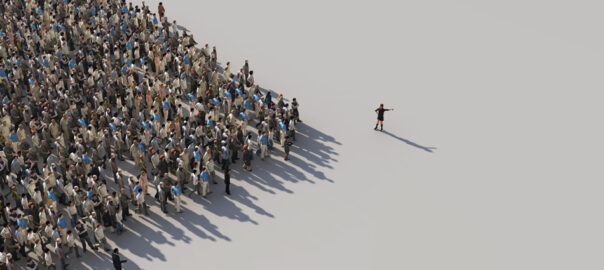
How to Improve Group Decision-Making
John Zada | December 8, 2022
Many human achievements stem from our special ability to band together and work in groups. By doing so we not only generate social dividends, but also enhance and magnify our effectiveness as individuals. Cooperation is how gargantuan megastructures like the Neolithic-era temples and the ancient Mesopotamian ziggurats get built, astronauts propel themselves into space and back, and how a million smaller successes are achieved every day.
But there is a serious paradox built into this usually-advantageous group dynamic: the collective, in its zeal for cohesion, can often stifle initiative and originality and thereby predispose itself to mediocrity and failure.
The reason for this isn’t hard to grasp. Regardless of the enterprise, whether we are on the hunt, fighting a war, or building a commercial enterprise, a high degree of group solidarity—a single-mindedness of purpose and action—is required for success. Too much disagreement or working at cross-purposes is counter-productive, which is likely why we seek out like-minded people and demand conformity in our groups. It’s hard-wired in us to some degree.
But that tendency, like anything else, can overreach with negative consequences. In excess, it can negate one of the greatest assets of any group: dissenting views and a diversity of perspective.
We’ve all seen or experienced this drive towards uniformity. Companies, organizations and other collectives tend to cherry-pick their recruits based on a certain ‘type.’ Once brought in, they are further homogenized through various pressures. Groupthink dynamics create a singularity of perspective. Dominance hierarchies and status considerations discourage the less influential from sharing dissenting views that might more accurately reflect reality and be beneficial for the group.
Author Matthew Syed, in his book Rebel Ideas, argues that these group dynamics can be deadly for organizations and companies as they create monocultures and encourage myopic thinking that result in cognitive errors or mistakes.
Syed cites the failure of the American intelligence community to predict and thwart the September 11 attacks. Another notable example is the bad team decisions at the heart of the disastrous 1996 Mount Everest climbing expedition made famous in Jon Krakauer’s book Into Thin Air.
Syed also tells us that mistakes have occurred, costing lives, in both the healthcare and airline industries when subordinate staff were too intimidated to contradict the errors in judgment made by their superiors. Airline pilots and surgeons wield military-like authority over their juniors. Because of this, it is extremely difficult for subordinates to bring themselves to voice their observations, let alone convince their higher ups of their mistakes.
I’ve also seen similarly poor outcomes result from discouragement of dissent during my time working as a television news writer and producer. The hard news business can be just as fanatically top-down in its decision-making hierarchy as the most martial organizations. In such environments, when there are also exceedingly strict deadline requirements, and everyone is working furiously on autopilot to get their jobs done on time, dissenting feedback about the quality, appropriateness, or treatment of any given story, is often shot down. In this case, society pays the price for the inability of the organization to harness the strength of multiple perspectives to improve its product.
So, what is the takeaway from this?
Syed says groups can avoid the crippling damage that this myopia can cause by actively seeking and building what he calls “cognitive diversity.” He defines this as group diversity marked by differences in the perspective, experiences and thinking styles among its members. When diversity in a group is embraced and encouraged—rather than quashed—it results in a kind of easygoing natural feedback, which he calls “rebel ideas.” That feedback provides a wider range of options for the collective for seeing the world, and navigating it.
“Groups that contain diverse views have a huge, often decisive, advantage,” he writes.
One ‘rebel ideas’-type technique Syed references is the use of what he calls a ‘shadow board’: which is a group of young people, drawn from within the ranks of an organization, to advise executives on key decisions and thus lift the conceptual blinkers that can attach to age. The Italian high-end fashion company Gucci, he says, is one such organization to have employed a shadow board to great effect. The company’s sales increased 136% in the first four years since they started using the board, which interact with the senior team on all major decisions.
These types of open-minded collectives, Syed says, tend to make far better decisions because they accept divergent views and see the bigger picture, while still retaining the necessary cohesion, leadership and hierarchy required to effectively channel its energy to get things done.
John Zada is a writer and journalist based in Toronto, Canada. He is the author of the books, In the Valleys of the Noble Beyond and Veils of Distortion.
Recent Blogs
- An Old Story About Metaphysics
- The Conditioning Machines in Our Back Pockets
- Out on a Limb: The Danger of our Innate Shortsightedness
- Edward T. Hall: Culture Below the Radar
- The Half Brain Method
- 'He Who Tastes Knows': Contemporary Sufi Studies and the work of Idries Shah
- "They Saw a Game"
- A Funny Thing Happened on the Way to Enlightenment
- Finding the Right Way Home
- Time and Self
- Escaping the Either/Or Thinking Trap
- Looking Up, Looking Out
- Conditioning and the Gendered Brain
- New World, Same Mind?
- One Small Word
- Meaning: The Enduring Gift to Spirit
- Beyond East and West: Human Nature and World Politics
- Forest Smarts: A Part of or Apart From?
- How to Improve Group Decision-Making
- We Know More Than We Think We Do
- How Deep Can a Story Go?
- Lost and Found: An Encounter with the Intuitive Mind
- The Devil’s Tuning Fork
- Welcome to The Human Journey Blog
